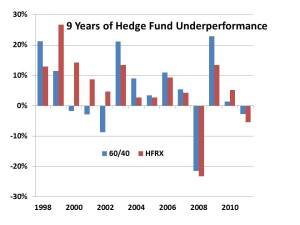Hedge Funds Need Smart Investors
My book, The Hedge Fund Mirage, will be out in early January. Its one sentence description is that all the money ever invested in hedge funds would have earned a higher return in treasury bills instead. It’s not that there aren’t some great hedge fund managers out there – of course there are. And there are some investors who have done very nicely too. But the aggregate results are not so pretty. Hedge funds have been highly profitable – it’s just that those profits haven’t found their way to the clients. When I describe the book’s premise to people in the hedge fund industry, they invariably chuckle and note that they’re not surprised. The Math is hard to refute. But the message is more positive than that.
It is possible to invest in hedge funds and earn attractive returns. One of the ways is to select smaller funds – the vast majority of hedge funds did better when they were smaller, and so did the industry as a whole. The Financial Times has an article showing the results of some research they carried out. Investing in smaller funds (which they define as having assets under management below $500MM) does not assure success, but they found it was a good place to start. Careful due diligence was necessary to ensure the quality of returns, valuation procedures and other qualitative metrics were acceptable. It illustrates that investing in hedge funds the old-fashioned way, as it was done in the 90s, is the way to earn old-fashioned returns. You have to look beneath the radar screen, to go where most investors are not going.
Barron’s also ran an article suggesting that fees are beginning to moderate. It’s certainly about time the “2 & 20” was adapted to better reflect the return outlook. But my favorite line in the article is a quote from Larry Powell, deputy chief investment officer of the Utah Retirement Systems, who notes that not all hedge fund investors view the world the way he does by commenting, “There are a lot of smart investors; however, there are a lot more dumb ones.” The world needs more smart investors. I hope Larry finds my book helpful.
